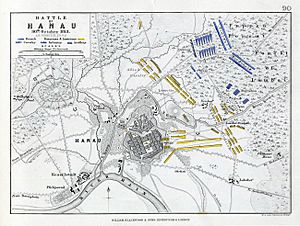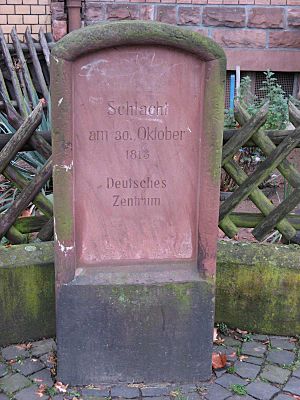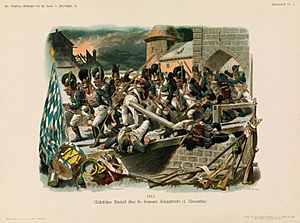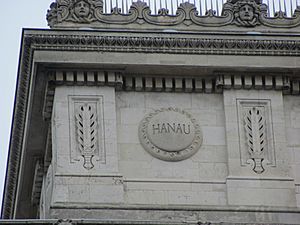Battle of Hanau facts for kids
Quick facts for kids Battle of Hanau |
|||||||
|---|---|---|---|---|---|---|---|
| Part of the German campaign of the Sixth Coalition | |||||||
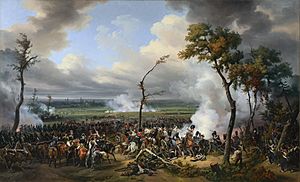 Battle of Hanau, Horace Vernet |
|||||||
|
|||||||
| Belligerents | |||||||
| Commanders and leaders | |||||||
| Strength | |||||||
| 17,000-30,000 | 40,000-43,000 | ||||||
| Casualties and losses | |||||||
| 4,500-5,000 killed and wounded | 6,000 killed and wounded 4,000 captured |
||||||
The Battle of Hanau was a major fight that happened from October 30 to 31, 1813. It was part of the War of the Sixth Coalition, where many European countries teamed up against Napoleon and his French army.
After a big defeat at the Battle of Leipzig, Napoleon's army was trying to retreat from Germany back to France. A combined army of Austrian and Bavarian soldiers, led by Karl Philipp von Wrede, tried to stop them near the city of Hanau.
Napoleon arrived with more troops and managed to defeat Wrede's forces. This victory on October 30 and 31 allowed Napoleon's army to continue their retreat safely into France.
Contents
Why the Battle of Hanau Happened
The Battle of Leipzig was a huge battle in October 1813. It was one of the biggest and bloodiest fights of the Napoleonic Wars. Napoleon's army lost badly, and he had to quickly leave central Germany.
His plan was to gather all his soldiers near the Rhine river in France. This would make it easier to get supplies and protect his army. Napoleon wanted his tired army to move very fast to avoid another big fight.
The countries fighting against Napoleon, called the Sixth Coalition, were also very tired after Leipzig. So, they couldn't chase Napoleon's army very quickly. This gave Napoleon time to reorganize his troops.
Bavaria Joins the Coalition
During this time, something important happened: Bavaria, which used to be Napoleon's ally, decided to join the Coalition. This was agreed in the Treaty of Ried.
This change allowed a large army of 45,000 to 50,000 Austrian and Bavarian soldiers, led by General Karl Philipp von Wrede, to move behind Napoleon's army. They took control of Würzburg, a city in Germany.
From Würzburg, Wrede's army moved towards Hanau. Hanau was important because it was on one of the main roads Napoleon's army was using to retreat. On October 28, Wrede's soldiers reached Hanau and took over the city. This blocked Napoleon's path to Frankfurt and then to France.
Wrede thought Napoleon's army was completely disorganized and much smaller. He hoped to play a big part in defeating Napoleon.
Armies at Hanau
The armies at Hanau were made up of two main sides: the Coalition (Austrian and Bavarian) and the French.
Coalition Army Forces
The Coalition army had about 42,000 soldiers. This included 33,000 foot soldiers (infantry), 9,000 horse soldiers (cavalry), and 94 cannons. General Karl Philipp von Wrede from Bavaria was in charge of this army.
The Austrian part of the army had 24,000 men. The Bavarian part, led directly by Wrede, had 18,000 men.
French Army Forces
Napoleon's French army had suffered huge losses at the Battle of Leipzig. Many of their fighting groups were much smaller than usual.
Emperor Napoleon I personally led the French forces. He had between 40,000 and 50,000 men in total. However, only about 30,000 of them were ready to fight.
Napoleon used soldiers from several different groups, including his best troops, the Imperial Guard. Many French units had only about 100 men, and cavalry groups were also very small. In the battle, Napoleon used about 20,000 of his men.
Preparing for Battle
On October 29, General Wrede decided his army was strong enough to stop Napoleon's retreat. He prepared his soldiers for a defensive fight. Wrede placed most of his army along the Kinzig River, on the opposite side from Hanau.
His left side protected the main road to Frankfurt and Mainz, which was the path Napoleon wanted to take. Some of his troops were in an advanced position in the Lamboy forest. Most of his cavalry was in the middle, behind the first line of soldiers.
Napoleon spent the night nearby and learned about Wrede's plans. He realized Wrede intended to block his path. Napoleon sent his army's supplies and baggage north, away from the enemy. He then led his main forces directly towards Wrede's army.
Napoleon noticed a big weakness in Wrede's plan: most of Wrede's army had the Kinzig River behind them. This meant if they had to retreat, the river would block them. Napoleon famously joked about Wrede's poor strategy. Even with fewer soldiers, less cavalry, and fewer cannons, Napoleon planned to attack this weakness.
The Battle Begins
On October 30, Wrede had his army ready to face Napoleon's forces. He placed his center with the Kinzig River behind it. His right side was separated from the main force by the river, connected only by one bridge. Napoleon had about 17,000 troops ready to fight Wrede's larger army.
Because of thick forests, the French could get very close to the Coalition forces without being seen. Napoleon decided to attack the Coalition's left side with all his available troops.
By midday, French marshals Victor and MacDonald had cleared the forest in front of the Coalition's center. Soon after, General Antoine Drouot found a path in the forest where cannons could be moved.
Decisive French Attack
Three hours later, the Grenadiers of the Old Guard cleared the area of Coalition troops. Drouot then set up 50 cannons, supported by French cavalry. A quick cannon attack from Drouot's guns silenced Wrede's 28 cannons.
French cavalry then charged and pushed back Wrede's cavalry on his left side. They then attacked the side of Wrede's center. Wrede's center began to fall back, moving along the Kinzig River, and many soldiers were lost.
On the right side, Wrede's soldiers tried to cross the single bridge over the Kinzig River to help the center. However, many drowned trying to cross. Wrede managed to gather his remaining troops to form a new defensive line. During the night, the Coalition forces left Hanau. The French took over Hanau on October 31 with little fighting. Napoleon did not chase Wrede's army. The main road to Frankfurt was now open, and the French retreat continued.
What Happened After the Battle
Wrede's army lost about 9,000 soldiers. Napoleon's army lost fewer soldiers in the battle itself. However, about 10,000 French soldiers who had fallen behind the main army became prisoners of war between October 28 and 31.
The French army reached Frankfurt on November 2, 1813. They were then only about 20 miles from their safe base at Mainz. This allowed Napoleon's army to rest and get ready to face the next challenge: the invasion of France in 1814.
Napoleon was not stopped or slowed down on his way to Frankfurt. The Battle of Hanau was a costly victory for Napoleon, but it achieved his goal. Wrede failed to block Napoleon's path, even though the Coalition forces had tried to cut off Napoleon's retreat.
The Kingdom of Bavaria wanted to show its support for the Coalition by fighting this battle. For Bavarian leaders, it was important that the battle happened, regardless of whether they won or lost. On November 5, 1813, Alexander I of Russia marched into Frankfurt with his troops.
A famous piece of music, Beethoven's Symphony No. 7, was first performed in Vienna on December 8, 1813. Beethoven himself conducted it at a charity concert for soldiers who were wounded in the Battle of Hanau.
Honors and Memorials
Many officers who fought well in the battle received special honors and medals. For example, Karl Philipp von Wrede received several medals from the Austrian and Russian Empires.
To remember the Battle of Hanau, several memorials were built in the city of Hanau. Five of these memorials can still be seen today. The battle is also listed on the Arc de Triomphe in Paris, among the battles won by Napoleon.
In 2015, about 200 remains of French soldiers who died in the battle were found at the battle site.
Images for kids


